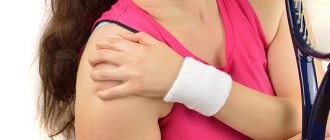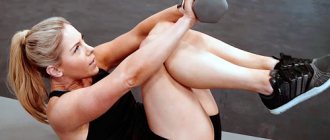Often, severe knee injuries occur in people whose lives include active sports - football, ice skating, alpine skiing. In everyday life, severe injuries to the knee joint are rare, since this area is reliably protected from traumatic disorders. There are different types of injuries, accompanied by characteristic symptoms. If a person feels that the joint is damaged, it is important to immediately go to the hospital and begin treatment.
Causes
The patella is usually injured when falling directly onto the knee.
In most cases, the mechanism of injury to the patella is direct - the injury occurs due to a fall on a bent leg and excessive force on the kneecap. Sometimes injuries can be caused by a blow to the knee joint (for example, during sports training, in a fight, traffic accident, etc.).
Sometimes in children or adolescents, an avulsion fracture of the patella can be caused by excessive contraction of the quadriceps femoris muscle. Injuries are caused by an indirect mechanism of injury. In addition, in the medical literature there are descriptions of cases where a fracture of the patella was provoked by a strong and directed tension of the tendons - under the influence of excessive force, the cup was literally torn into upper and lower parts.
Anyone can hit their knee at any time. Such injuries may be mild, but in some cases they lead to significant deformation of the cartilage, ligament tears and fractures. That is why knee injuries should not be ignored and the victim should undergo examination and treatment by a specialist. At home, only a mild bruise can be treated, which is not accompanied by severe pain and the appearance of significant swelling or hematoma.
Primary sources of information, scientific materials on the topic
- Knee joint: damage and pain syndromes. Guide to the diagnosis and treatment of injuries and certain diseases of the knee joint. Girshin S.G., Lazishvili G.D., 2007.
- Traumatology and orthopedics. Management. Kornilov N.V., St. Petersburg, vol. 2, pp. 56–58, 197–201.
- First medical aid, textbook. Buyanov V. M. M.: Medicine, 2000, pp. 56, 174, 192.
- First aid for injuries, accidents and some diseases. Bulay I.P., Mn.: Belarus, 1984, p. 48.
- Traumatology and orthopedics. Kavalersky G. M., Silin L. L., Garkavi A. V., M.: Medicine, 2008, pp. 149–152, 202–207.
- Knee surgery. Kushner Fred D., Scott Norman W., Scuderi Giles R., 2014.
https://youtu.be/MsmYQcU9aOU
Symptoms of a bruised patella
When a kneecap is bruised, the victim experiences the following symptoms:
- pain that appears immediately after the blow;
- easing of pain a few minutes after the injury (with a slight bruise, they disappear completely);
- swelling and swelling of the area of injury (sometimes with mild bruises such manifestations are expressed almost imperceptibly);
- limitation of movements of the knee joint: inability to fully bend and straighten the leg, pain when walking;
- hemorrhage (occurs when blood vessels rupture): in the first days, the color of the hematoma is bright pink with a bluish tint, after a few days the bruise becomes brown, and then turns yellow and resolves.
In some cases, a strong impact can damage large vessels. Due to their rupture, the patient develops a very large hematoma, which can only be removed by a doctor.
Experts recommend that if you have a bruised patella, you should consult a doctor when the pain does not go away within 24 hours or significant bleeding occurs on the surface of the knee. This measure is explained by the fact that bruises of the kneecap are often accompanied by other more severe injuries: ligament rupture, meniscus damage, bone fractures.
Diagnostics
Before starting pathology treatment, it is necessary to determine the extent and type of injury. For open and closed injuries, the traumatology department will handle the treatment. During the initial examination, the doctor will examine the knee joint and use the Lachman test to evaluate the medial and lateral stability of the joints. To confirm the diagnosis, the patient will be sent for X-ray examination, MRI and CT, thanks to which it will be possible to see the extent of the disorder and whether there are contusions of the tibial condyles.
First aid for bruise
In case of knee bruises, the victim should be given first aid:
- Sit the injured person down and stop moving the knee.
- If there are abrasions or scratches, treat their surface with an antiseptic solution.
- Apply ice to the area of injury to relieve pain, reduce bleeding, and prevent swelling from spreading. The cold should be removed from the skin every 10 minutes, as prolonged exposure to low temperatures can cause frostbite.
- If the use of cold does not reduce pain, then the victim should take a painkiller (Nise, Diclofenac, Analgin, Ketorol). For intense pain, an intramuscular injection of Ketonal or Dexalgin is performed.
- To limit movements in the knee joint, a tight elastic bandage is applied to the knee. When applying a bandage, it should be taken into account that the bandage should not strongly compress soft tissues and blood vessels, but the bandage should fix the knee well.
If a very large hematoma has formed on the knee or the pain has not gone away a day after the injury, the victim should consult a doctor for an examination. A visit to the doctor should not be postponed, as the injury may subsequently become more complicated and treatment will require more time.
Traditional methods
For those who know what to do with “grandmother’s” recipes, there is good news. A knee injury can be cured without the help of modern medicine . To do this, you will need to mix pork fat with finely crushed plantain leaves until a homogeneous consistency is formed. This ointment is applied to the site of the bruise. An alternative remedy can be boiled semolina mixed with steamed cinquefoil leaves.
A few days after the injury, the bruised area begins to warm up. This speeds up the healing process. Traditional medicine has stocked up with an impressive variety of recipes for warming compresses. In the winter season, you can make compresses from dry wormwood with Vaseline several times a day. To do this, you need to move the components and put them in the oven for a couple of hours.
Take 100 g of hop cones and pour 400 ml of vodka over them, let it brew for several days, and then strain. The resulting solution is an excellent remedy for warming compresses. For those who like to experiment with herbs, you can prepare the following decoction to treat a bruise. Coltsfoot is mixed with oregano, 20 grams each, then crushed and poured with vodka in an amount of 500g. The mixture is infused for several days, stirring occasionally, then filtered and used for night compresses.
Symptoms and types of patellar fracture
Patellar fractures occur when there is a strong impact to the knee. Experts identify 7 types of patella injuries:
- horizontal without displacement - the cup breaks along the horizontal axis into two parts;
- horizontal with displacement – the injury occurs in the same way as the previous one, but the fragments of the cup are displaced to the side;
- vertical - the cup breaks along the vertical axis into two parts;
- comminuted without displacement - the body of the patella is torn into several parts, but they do not move to the sides;
- multi-fragmented with displacement - the body of the calyx breaks into several parts, and they move to the sides;
- separation of the lower edge - the body of the patella remains intact, but approximately 1/8 of its part is torn off from the bone;
- osteochondral - the injury is accompanied by the breaking off of a piece of the articular surface.
Horizontal fractures of the kneecap occur most often.
When a fracture occurs, the victim experiences very severe pain in the knee area, and to relieve it, he tries to position his leg so that the sensation becomes a little weaker. Sometimes the pain extends above or below the knee joint. Attempts to touch the knee cause a significant increase in pain, and because of this it may be impossible to feel the kneecap.
In some cases, the pain from an injury is so severe that the victim develops pain shock. This condition is manifested by an attack of nausea and the urge to vomit. In some cases, the patient loses consciousness.
In addition to pain, a fracture of the patella is accompanied by the following symptoms:
- inability to raise a leg;
- severe swelling in the area of injury (with arterial ruptures, swelling increases rapidly);
- signs of hemarthrosis (accumulation of blood in the joint): sensations of fullness in the knee and even greater limitation of movements;
- hematoma in the area of injury;
- sinking of soft tissues between fragments of the kneecap (in case of fractures with displacement of bone fragments);
- crepitus when trying to move the joint;
- change in the appearance of the kneecap.
All of the above manifestations may indicate not only a fracture of the patella, but also damage to the knee condyle. In order to ensure that the integrity of the kneecap has been compromised, a “sticky heel” test should be performed:
- The injured person is placed on a soft surface and asked to try to lift his leg.
- If he cannot perform such an action, then this indicates a fracture of the kneecap.
Damage to the capsular apparatus of the knee joint
Signs of damage to the knee joint may be present when the integrity of the joint capsule is compromised. It can be subject to stretching, rupture and scar deformation if there is instability in the position of the condyles of the tibia and femur. The most common cause is destruction of one or both menisci.
Damage to the capsular apparatus of the knee joint leads to negative consequences. Instability of the position of the bone heads occurs. Constant dislocations and sprains of ligament and tendon tissue are provoked. Ultimately, this leads to the development of deforming osteoarthritis, ligament ruptures, etc.
First aid for a fracture
An ice pack can help reduce pain and swelling of an injured knee.
Every 10 minutes, to prevent frostbite, the ice should be removed from the foot. To prevent complications in the event of a fractured patella, the injured person should be provided with pre-medical care:
- Calm the victim, give him a drink of water, explain his condition and ask him not to panic and not make unnecessary movements. Help him take the position in which the pain in the knee will be least pronounced.
- Call an ambulance.
- Give the patient a non-narcotic analgesic: Analgin, Ketorol, Dexalgin. Or perform an intramuscular injection of the same drugs.
- If there are open wounds, treat their surface with an antiseptic solution.
- Immobilize the limb with a splint.
- Apply ice wrapped in a towel to your knee. Every 10 minutes the cold should be removed from the foot to prevent frostbite. This measure will slightly reduce pain and stop the spread of hematoma and swelling.
- Take the victim to the hospital, trying to keep the injured leg immobile.
Treatment of a bruised patella
Treatment for bruises of the patella is carried out using conservative measures. For prolonged pain, the patient is recommended to re-take non-steroidal anti-inflammatory drugs that have an analgesic effect. A tight elastic bandage is applied to the knee joint. At home, the victim should try to provide the leg with an elevated position more often - this measure will help reduce swelling and help relieve pain.
If after a day the pain does not become weaker and the swelling does not subside, then the injured person should visit a doctor. In such cases, the bruise may be accompanied by rupture of the joint capsule and damage to large vessels, provoking the development of hemarthrosis.
In case of a complicated course of the injury, the victim undergoes a puncture of the knee joint to remove the blood accumulated in it. After the procedure, an immobilizing bandage is applied to the knee, which should be worn for 3 weeks. In addition, the use of chondroprotectors (Fermatron, Collagen-ultra, etc.) and the application of anti-inflammatory ointments (Lioton, Heparin ointment, Troxevasin gel, etc.) are prescribed. After 7 days, treatment can be supplemented with physiotherapy: electrophoresis, massage, UHF, dynamic current therapy. Somewhat later, the doctor recommends doing exercises to restore joint function.
The duration of healing of a bruise depends on its severity and the presence of complications. Typically, the knee joint recovers after a patellar injury within a month. After this, the victim is recommended to spare the injured limb, wear a knee brace and gradually increase the load on the leg. Full recovery from injury occurs in about a year.
Meniscus injury
The most common type of knee injury. Often the internal meniscus is damaged. And in the event of an external injury, the usual functionality of the joint often deteriorates.
- acute pain at the site of the injury;
- the occurrence of swelling of soft tissues;
- deterioration in performance;
- the appearance of hemarthrosis;
- formation of abrasions, bruises and scratches.
If effusion is detected in the joint cavity, a puncture is performed.
https://youtu.be/ROlqjoK_xio
Diagnostic methods are considered:
- survey;
- X-ray;
- Ultrasound;
- magnetic resonance therapy;
- arthroscopy procedure.
This type of knee joint injury requires only surgical intervention. During the operation, the doctors’ task is to restore the cartilage plate and remove its dead particles. On the tenth day, the doctor prescribes rehabilitation after a knee joint injury, which consists of performing developmental exercises, attending massage treatments and physiotherapy.
Treatment of a patellar fracture
The treatment strategy for a patella fracture is determined by its stability. Stable fractures are those injuries in which there is no tendency to displace fragments (for example, vertical fractures). Unstable injuries are considered to be patellar fractures that are already accompanied by displacement, or such a phenomenon may occur in the future. The nature of the patella fracture is determined by the doctor in each clinical case based on X-ray data.
With a stable fracture, conservative measures may be sufficient to repair the damage. Depending on the clinical case, the knee joint is immobilized in a slightly bent or straight position with a plaster or orthosis. The duration of immobilization for such fractures ranges from 1 to 2 months. During this time, X-ray monitoring of the damage is carried out and thus the date for removal of the orthosis or plaster cast is determined. After this, the patient is recommended to undergo rehabilitation.
If, during a fracture of the kneecap, the bone fragment is displaced even by 3 mm, then this manifestation of the injury is an indication for surgical treatment. Only this method allows you to bring the fragments closer together and achieve their fusion. Otherwise, they will not be able to grow together on their own, and in the future the victim will not be able to bend and straighten the knee due to severe arthrosis.
During surgery, the doctor achieves maximum comparison of bone fragments, fixes them with special metal devices (wire, screws or Weber) and forms the articular surface. In case of horizontal fractures or comminuted fractures, bone fragments are fixed with knitting needles and medical wire. In other clinical cases, screws are used. When the lower part of the kneecap is fractured, the bone fragment is removed and the ligaments are sutured.
After the operation is completed, a brace or plaster is applied to the knee joint. On the first day after the intervention, the limb should be in an elevated position to prevent the increase in edema. During the postoperative period, several radiographs are taken to monitor the quality of treatment.
In addition, after surgery, the patient is recommended to perform therapeutic exercises to reduce the risk of thrombosis. The volume of such loads is determined by the doctor. Exercises can be performed only in the absence of pain, and the occurrence of any discomfort should be a reason to stop exercising.
In some cases, in the postoperative period it is necessary to perform a puncture of the knee joint to remove the blood accumulated in it.
Rehabilitation after a patellar fracture
Exercise therapy exercises will help restore the functions of an injured patella.
After applying an orthosis or plaster cast, the patient is allowed to use crutches. At this stage, it is recommended to perform toe movements, which eliminate congestion and maintain muscle tone. After about 3 days, the movements are supplemented with therapeutic exercises that restore all the muscles of the injured leg. These activities are complemented by massage.
At the first stage of rehabilitation, the following exercises are performed to develop fine motor skills and foot muscles:
- flexion and extension of fingers;
- circular movements in the ankle joint;
- slight movements in the knee.
During this same period, resistance exercises and breathing exercises begin, which help saturate the blood with oxygen and speed up the healing period of the bone.
In the second stage of recovery, physical therapy exercises are performed in bed and are aimed at restoring the function of the knee joint. Usually the patient is recommended the following complex:
- bending and straightening the leg at the knee while supporting the hips with the hands;
- flexion and extension of the legs with limbs hanging from the bed;
- rolling your legs from heels to toes while sitting on the bed.
The third stage of rehabilitation is aimed at complete restoration of the joint. Now the patient can move without crutches and the load on the injured leg gradually increases. The following set of exercises is performed:
- leisurely walking (up to 3 km/h) and walking up the stairs at a side step;
- lifting the injured limb to the 3-5 step of the gymnastic ladder;
- transferring the weight of the body to one and the other leg in a standing position with legs apart at a comfortable width;
- squats with support;
- lunges with the leg forward and backward (first, the lunge is done on the healthy leg, and when lunging on the injured leg, a backup is provided with the help of a support);
- climbing a gymnastic wall;
- in a position on all fours, move along the floor without lifting your feet (movement should be accelerated gradually);
- jumping on an injured leg (performed only in the absence of pain).
Such exercises do not begin to be performed all at once. The specialist gradually adds certain techniques to the complex and determines the load in accordance with the patient’s condition.
https://youtu.be/0AymA0z5dEY








